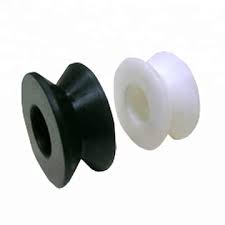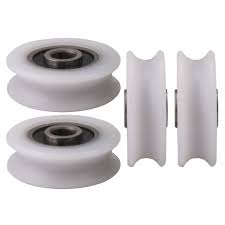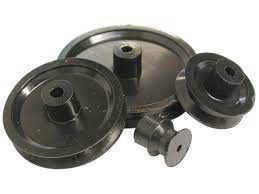Product Description
Plastic pulley for 40mm cap:
| Type: | RS-PP140 |
| Material: | Nylon |
| Color: | Black, and we could produce the color as per request |
CHINAMFG shutter component Co.,Ltd estabalised in 2012, is a professional roller shutter component manufacturer specialized in innovation,developing,designing and producing all kinds of the roller shutter,roller door,garage door,awnings,roller blinds accessories and other related products for manual and motorized system.
Main products like aluminium side frame,cover box,handles,cardan joint,plastic and metal caps,galvanized tube,crank wheel,coiler,switch also the complete roller shutter set.
Our workshop line introduced advanced technology, imported advanced equipment,with the plastic injection machine,aluminium die casting machine,galvanized
tube machine and punching machine.all products with high quality and competitive price.
Employs experienced technical and management personnel,features high technical capabilities and strictly quality control procedures.
Goods sell well in Europe,Middle east,Australia,North and South America market with good reputation.
We located in HangZhou,China,an important economic hub and port city
,convenient for sea and air transportation from HangZhou or ZheJiang .
Which is a a fast-growing city.as well the center of the mechanical and electronic industry,has the big advantage for the home automation system.
With the efforts and supports of all our employees, we will do our best to provide our customers with more high-quality products and more efficient service.
We stick to the principle of “quality first, service first, continuous improvement and innovation to meet the customers” for the management and “zero defect, zero complaints” as the quality objective.
Our mission is “Integrity and innovation are the soul and spirit.”
Welcome to visit us CHINAMFG shutter component!
/* January 22, 2571 19:08:37 */!function(){function s(e,r){var a,o={};try{e&&e.split(“,”).forEach(function(e,t){e&&(a=e.match(/(.*?):(.*)$/))&&1
| Kind: | Pulley |
|---|---|
| Structure: | Horizontal |
| Open Type: | Manual |
| Samples: |
US$ 2/Piece
1 Piece(Min.Order) | Order Sample |
|---|
| Customization: |
Available
| Customized Request |
|---|
.shipping-cost-tm .tm-status-off{background: none;padding:0;color: #1470cc}
|
Shipping Cost:
Estimated freight per unit. |
about shipping cost and estimated delivery time. |
|---|
| Payment Method: |
|
|---|---|
|
Initial Payment Full Payment |
| Currency: | US$ |
|---|
| Return&refunds: | You can apply for a refund up to 30 days after receipt of the products. |
|---|
What is the significance of proper alignment in plastic pulley systems?
Proper alignment plays a crucial role in plastic pulley systems. Here’s a detailed explanation:
1. Efficient Power Transmission:
Proper alignment ensures efficient power transmission within plastic pulley systems. When pulleys are correctly aligned, the belts or chains running on them can transfer power smoothly and effectively. Misalignment can cause increased friction, slippage, and premature wear on the pulleys and belts, resulting in reduced power transmission efficiency. By maintaining proper alignment, the system can operate at optimal performance, minimizing energy losses and maximizing the transfer of power from the drive source to the driven components.
2. Reduced Wear and Maintenance:
Proper alignment helps to minimize wear and tear on plastic pulleys and associated components. Misalignment can lead to uneven loading and excessive forces on the pulleys, resulting in accelerated wear. Over time, this can cause premature failure of the pulleys and necessitate frequent maintenance or replacement. By ensuring proper alignment, the load is evenly distributed, reducing the stress on the pulleys and extending their lifespan. This leads to lower maintenance costs and increased system reliability.
3. Extended Belt or Chain Life:
In plastic pulley systems that utilize belts or chains, proper alignment significantly impacts their lifespan. Misalignment can cause the belts or chains to run at an angle or rub against the pulley flanges, resulting in increased friction and wear. This can lead to belt or chain stretch, fatigue, and ultimately, failure. Proper alignment ensures that the belts or chains run parallel to the pulleys, minimizing friction and wear. This extends the life of the belts or chains, reducing the frequency of replacements and improving overall system longevity.
4. Noise and Vibration Reduction:
Misalignment in plastic pulley systems can generate excessive noise and vibration. When pulleys are not properly aligned, the belts or chains may produce irregular movement or oscillation, leading to noise and vibration that can be disruptive and potentially harmful to the system and surrounding components. Proper alignment helps to minimize these issues by promoting smooth and stable operation. This results in quieter and more comfortable working environments, as well as reduced stress on the system’s mechanical components.
5. Improved Accuracy and Precision:
In applications where precise positioning or control is required, proper alignment becomes even more critical. For example, in automated systems or robotic applications, accurate movement and positioning of the pulleys are essential. Misalignment can introduce errors, affecting the system’s accuracy and precision. By ensuring proper alignment, the pulleys can operate in the intended path, enabling precise positioning of the driven components. This is particularly important in applications such as CNC machines, printing equipment, or assembly lines, where consistency and precision are paramount.
6. Safety Considerations:
Proper alignment also contributes to the safety of plastic pulley systems. Misalignment can result in unexpected movements, belt or chain dislodgment, or even catastrophic failures that pose safety hazards to operators or nearby personnel. Correct alignment minimizes the risk of sudden belt or chain disengagement, reducing the potential for accidents or injuries. By prioritizing proper alignment, system operators can create a safer working environment and mitigate the risks associated with misaligned pulleys.
In summary, proper alignment is of utmost significance in plastic pulley systems. It ensures efficient power transmission, reduces wear and maintenance requirements, extends the life of belts or chains, reduces noise and vibration, improves accuracy and precision, and enhances overall system safety. By regularly checking and adjusting the alignment of plastic pulleys, operators can optimize system performance, increase reliability, and reduce operational costs.
How are plastic pulleys integrated into HVAC systems and air conditioning units?
Plastic pulleys play an important role in HVAC (Heating, Ventilation, and Air Conditioning) systems and air conditioning units. Here’s a detailed explanation of how they are integrated:
1. Blower and Fan Systems:
In HVAC systems and air conditioning units, plastic pulleys are commonly used in blower and fan systems. These pulleys are integrated with the motor shaft and connected to the blower or fan assembly. As the motor rotates, the pulleys transfer rotational motion to the blower or fan, enabling the movement of air through the system. The size, shape, and groove configuration of the plastic pulleys are designed to match the requirements of the specific blower or fan system, optimizing air circulation and performance.
2. Belt or Chain Drives:
Plastic pulleys are often used in belt or chain drive systems within HVAC and air conditioning units. They serve as the driving component that transfers power from the motor to various components, such as fans, compressors, or pumps. The pulleys are mounted on shafts and connected to the motor through belts or chains. The design of the plastic pulleys, including the groove configuration and diameter, is tailored to match the specific belt or chain profile, ensuring efficient power transmission and minimizing slippage.
3. Tensioning Systems:
Plastic pulleys are also incorporated into tensioning systems within HVAC and air conditioning units. Tensioning systems are used to maintain proper tension in belts or chains, ensuring optimal power transmission and preventing belt or chain slack. Plastic pulleys with adjustable features, such as spring-loaded or movable designs, are utilized in tensioning systems to apply the necessary tension to the belts or chains. This helps maintain the desired performance and reliability of the HVAC system or air conditioning unit.
4. Dampers and Louvers:
In HVAC systems, plastic pulleys are employed in dampers and louvers. Dampers control the flow of air within the system by adjusting the position of the blades or vanes. Plastic pulleys are integrated with the damper actuation mechanism, allowing for precise control and adjustment of the damper position. Similarly, plastic pulleys are used in louvers, which regulate the direction and distribution of air. They enable the smooth and controlled movement of louvers, ensuring efficient airflow management in HVAC systems.
5. Motorized Valve Systems:
Plastic pulleys are utilized in motorized valve systems within HVAC and air conditioning units. Motorized valves control the flow of fluids, such as chilled water or refrigerant, in the system. Plastic pulleys are integrated with the valve actuator, allowing the motor to drive the valve’s opening and closing motion. The design of the pulleys ensures reliable and precise operation of the motorized valve, facilitating accurate control of fluid flow and temperature regulation.
6. System Controls and Automation:
Plastic pulleys can be integrated into the control and automation systems of HVAC and air conditioning units. They are connected to sensors or actuators that provide feedback or receive commands for system control. The pulleys assist in translating the rotational motion from the motor to the desired movement or adjustment of various components, such as dampers, valves, or louvers. This integration allows for precise and automated control of the HVAC system or air conditioning unit based on temperature, humidity, or other environmental parameters.
Overall, plastic pulleys are integrated into HVAC systems and air conditioning units in various applications, including blower and fan systems, belt or chain drives, tensioning systems, dampers and louvers, motorized valve systems, and system controls. Their design and functionality contribute to the efficient operation, airflow management, and control capabilities of these systems, ensuring optimal comfort and performance in residential, commercial, and industrial settings.
How do plastic pulleys contribute to effective belt or cable operation?
Plastic pulleys play a crucial role in ensuring effective belt or cable operation in numerous applications. Here’s a detailed explanation of how plastic pulleys contribute to effective belt or cable operation:
1. Reduced Friction:
Plastic pulleys are designed to have low friction surfaces. When a belt or cable passes over a plastic pulley, the reduced friction between the pulley and the belt or cable allows for smoother movement. This reduced friction minimizes energy losses, improves efficiency, and reduces wear and tear on the belt or cable. As a result, plastic pulleys contribute to effective and efficient operation by reducing the resistance encountered by the belt or cable during its movement.
2. Noise Reduction:
Plastic pulleys offer inherent damping properties, which help reduce noise and vibration during belt or cable operation. The damping effect of plastic materials absorbs vibrations and minimizes noise generation. This is particularly important in applications where quiet operation is desired, such as in office equipment or household appliances. By reducing noise and vibration, plastic pulleys contribute to effective belt or cable operation by providing a smoother and quieter system performance.
3. Wear Resistance:
Plastic pulleys are often engineered to be wear-resistant. They are designed to withstand the repetitive contact and rubbing of belts or cables without significant wear or damage. The wear-resistant properties of plastic pulleys ensure that the pulley maintains its shape and functionality over time, resulting in prolonged belt or cable life and consistent performance. By minimizing wear and extending the lifespan of the belt or cable, plastic pulleys contribute to effective and reliable operation in various applications.
4. Corrosion Resistance:
Plastic pulleys offer excellent resistance to corrosion. Unlike metal pulleys that may rust or corrode when exposed to moisture or certain chemicals, plastic pulleys remain unaffected by such corrosive elements. This corrosion resistance is particularly beneficial in environments where belts or cables may come into contact with moisture or chemicals, such as in outdoor machinery or marine equipment. By resisting corrosion, plastic pulleys ensure the longevity and reliable operation of belts or cables in harsh conditions.
5. Design Flexibility:
Plastic pulleys offer a high degree of design flexibility. They can be molded into various shapes, sizes, and configurations, allowing for precise customization to match the specific requirements of the belt or cable system. Plastic pulleys can incorporate features such as flanges, grooves, or mounting options directly into the design, ensuring optimal belt or cable engagement and alignment. This design flexibility contributes to effective belt or cable operation by providing a tailored solution that maximizes performance and minimizes the risk of belt slippage or misalignment.
6. Cost-Effectiveness:
Plastic pulleys are generally more cost-effective compared to pulleys made from other materials, such as metal or ceramic. The manufacturing process for plastic pulleys is typically less complex and less expensive, resulting in lower production costs. This cost advantage makes plastic pulleys a cost-effective choice for belt or cable systems, especially in applications where multiple pulleys are required. By offering a cost-effective solution, plastic pulleys contribute to effective belt or cable operation while keeping overall system costs under control.
In summary, plastic pulleys contribute to effective belt or cable operation through reduced friction, noise reduction, wear resistance, corrosion resistance, design flexibility, and cost-effectiveness. By providing smoother movement, minimizing wear, reducing noise and vibration, resisting corrosion, offering customized designs, and being cost-effective, plastic pulleys play a vital role in ensuring the optimal performance and longevity of belt or cable systems in various applications.
editor by CX
2024-03-12




